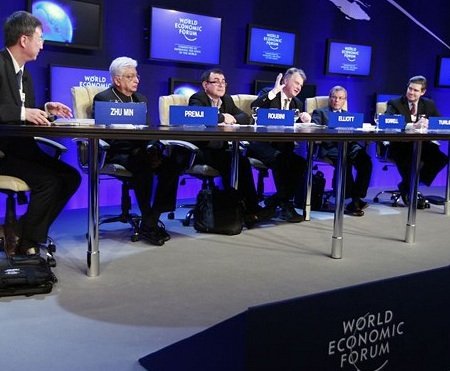Quite a bit it seems judging by the poverty projections in the new Brookings paper that shows what’s possible if inequality is unchanging. In short, much, much faster poverty reduction (and thus a cheaper aid budget too).
Not surprising perhaps, inequality seems to be very much back on the political radar judging by recent voices in the Economist, the World Economic Forum and the International Monetary Fund. Meanwhile the UN are promoting equity approaches to the MDGs with both UNICEF and UNDP leading the wider UN body.
The main trends are said to be rising inequality within many countries but falling inequality in some highly unequal countries across Latin America thanks to a mixture of cash transfers to the poor and expansion of education.
Inequality matters to poverty reduction because rising inequality reduces the effectiveness of growth for poverty reduction as well as having linkages to greater fragility/conflict via horizontal or group inequalities.
But exactly how much does inequality matter to global poverty reduction? Now we have a something of an answer – in an interesting study by Chandy and Gertz at Brookings.
Inequality matters to poverty reduction because:
a) Most of the poor now live in middle income countries (MICs);
b) Poverty reduction is much faster if inequality is at least static.
The Chandy and Gertz study is in agreement with the idea that there is a the ‘New Bottom Billion’ and the shift of world poverty towards middle income countries.
In terms of their poverty projections, the important issue for the numbers is that they are determined by growth and by changes in inequality. Chandy and Gertz give an insight into an optimistic 2015 world – one possible 2015 world – a good news one for the world’s poor – a world where inequality doesn’t rise from 2005 onwards – it stays the same and as a result global poverty reduction is much faster – falling to just 10% in 2015.
So, the study shows what’s possible in terms of global poverty reduction if governments address domestic inequality – or at least stop it rising – and the net result will determine the number of poor people to a large extent in 2015.
Dercon and Shapiro did a great review of the causes of poverty using a huge range of long run data sets. Here’s a 10 second summary: The key reasons to explain escaping from poverty are largely equity related: changes in economic and social assets (e.g. changes in employment, land, ownership and education) and/or social exclusion and discrimination and/or location in remote or otherwise disadvantaged areas.
In light of this what more could governments (and donors) do to make sure there’s shared prosperity? Here’s 3 things:
i. Government expenditure (and donor $s) could give greater favour to disadvantaged regions or groups.
Growth is a major potential source of government revenue to finance public expenditure, which can be designed to be explicitly pro-poorest, for example through broad based expenditure on education and health. This provides an important opportunity for the benefits of growth to be more widely shared, and in a manner which is not likely to have major disincentive effects that would crowd out future growth.
Other measures include quotas to support access to employment for specific excluded groups, services targeted at key stages of development, such as early childhood; lowering taxes on staple goods. Land reform is also crucial to provide the poor with productive assets.
ii. Public services free at the point of delivery for the poorest wherever possible.
There is rigorous evidence that even tiny changes in user fees reduce ‘demand’ considerably (ie what poor people can afford). For example, randomised evaluations show in Africa: raising bed nets from zero cost to $0.75 reduced demand for bed nets by 75%; a small fee for deworming drugs led to an 80% reduction in treatment rates; and when chlorine was supplied freely for 7-months, chlorine was detected in 58% of households, much more than the 2% starting level.
iii. Systematic social protection to ensure that nobody drops below a minimum level of wellbeing, beyond which unmet need will create cycles of disadvantage.
Options include: payments such as social insurance or basic income grants; conditional transfers to promote human development; minimum wage policies; guaranteed government employment programmes; and labour market regulations to those in employment.
Of course in the long run what matters is getting the poorest on the political radar and strengthening the political assets of the poorest via supporting the collective organisations of the poorest – producer organisations, informal sector unions; social movements and trade unions. If donors go down this route this all sounds potentially like a more political direction for aid?
One final twist to bring the inequality debate up to date – there were a whole range of little noticed papers last year (and the year before) not on the bottom billion (old or new) but on the (sometimes) ‘missing middle’ meaning the missing (or vulnerable) middle classes. Those papers suggested rather than thinking of the policy trade-offs arising from the poor versus the rest (as we currently do), instead we should think of the policy trade-offs of the rich versus the rest. The case for more attention to the ‘missing (or slim) middle’ in development policy is that as the middle classes emerge governance becomes more responsive as the tax base expands and there’s a social transformation to a lower level of inequality and political transformation follows as the social contract between elites and the mass of society is renegotiated.
What does this all add up to? Maybe inequality isn’t just about the ‘bottom billion’ (new or old). More focus on the slim or missing middle might be worth much more attention too in terms of thinking about aid as a catalyst for change.




